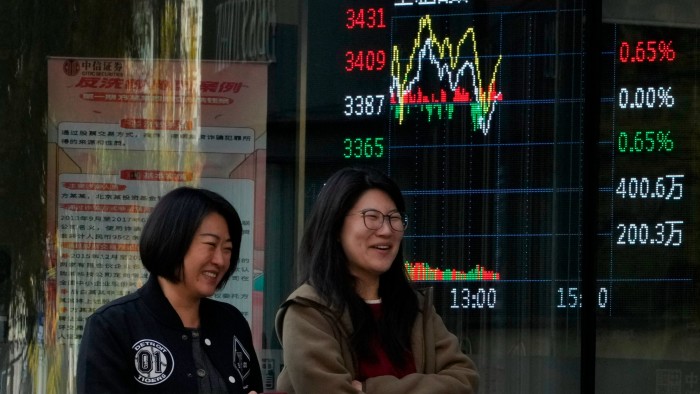Stay informed with free updates
Simply sign up to the Exchange traded funds myFT Digest — delivered directly to your inbox.
Latest news on ETFs
Visit our ETF Hub to find out more and to explore our in-depth data and comparison tools
A shift to passive funds in China offers a new opportunity for global firms to stand out among established local players in the rush to launch products tracking the recently created CSI A500 index.
But there are still question marks over whether global firms in China have sufficient onshore resources and if their experience offshore will help their new enhanced funds, which combine active management elements with index tracking, to outperform and attract assets.
China’s new CSI A500 index, which launched in September, has led to a slew of new exchange traded funds and index products that have already amassed between Rmb150bn ($20.7bn) and Rmb200bn in assets, buoyed by state efforts to channel more passive money into the stock market.
Li Yiming, senior manager research analyst at Morningstar, said investors in China tended to opt for new products rather than existing ones and the new CSI A500 Index had brought “a rare sense of freshness” to the market.
This article was previously published by Ignites Asia, a title owned by the FT Group.
Global fund firms in China needed to evaluate whether they have the resources and capabilities to roll out CSI A500 index products and then quickly execute those plans, before this sense of rareness waned, said Li.
“This is an urgent time window they better not miss,” he added.
There is growing demand for index-based investment among institutional investors in China due to the more transparent information on their holdings compared with active funds, according to a marketing executive at a global asset manager.
“Global fund houses sooner or later need to have equity index strategies in their product lines, especially if they want to appear as managers with comprehensive investment capability,” said the executive.
The CSI A500 index covers companies across a wider and more balanced range of sectors than the CSI 300 Index and could become the backbone of the index product line-up of global fund firms in China, the executive added.
Some global fund firms in China are joining the rush to launch new products based on the CSI A500 Index.
Last month BlackRock’s China fund unit applied to launch an enhanced CSI A500-based index fund.
This comes as the world’s largest asset manager kicked off fundraising on November 4 for its first equity index product in the market with an “enhanced” portfolio management strategy. The BlackRock CSI 300 Enhanced Index Fund adopts quantitative stockpicking methods with up to 8 per cent annualised tracking difference from the index.
Neuberger Berman last month also applied for an enhanced index fund tracking CSI A500, its first equity index fund since it received approval to launch business operations in November 2022.
Manulife also on October 15 filed application for its CSI A500 enhanced index fund, the first equity index fund since it won approval in 2022 to buy out its fund management joint venture.
These enhanced index funds, which aim to outperform the indices with active management elements such as quantitative methods and traditional analysis, can be seen as a better starting point for smaller global entrants if they want a shot in the CSI A500 race, according to experts.
Standard unlisted passive index funds focus on accurately tracking a base index, leaving little room to differentiate on performance, making it challenging for new global entrants to stand out in marketing and distribution, according to Morningstar’s Li.
The launch of the CSI A500 Index was accompanied by the launch of 10 ETFs tracking the index. However, among 22 fund companies in China that have launched or applied to launch ETFs tracking the index, the onshore unit of JPMorgan Asset Management is the only global fund house to do so.
Breaking into the ETF industry would require an asset manager to ready IT infrastructure worth tens of millions renminbi for real-time transactions, and may have to pay more to incentivise distributors, according to the fund executive.
“When a popular index is introduced fund firms also need to be among the first few companies to launch ETFs, because any delay could mean losing potential investors to rivals tracking the same index,” said the executive. “This is particularly challenging for global players that might have to go through months of internal protocols to get headquarters’ nods on product plans.”
But competition is no less fierce in the race to launch enhanced CSI A500 Index funds. More than 30 companies have filed such product applications.
Although launching enhanced index funds may offer global players better opportunities than ETFs or other passive funds in the CSI A500 Index race, outperforming rivals will be not straightforward, Morningstar’s Li cautioned.
Index funds enhanced with quantitative models must accurately reflect market shifts and manage risks, and use high-quality, comprehensive data to be successful, Li said.
“To what extent their global quantitative investment and active management expertise could fit into onshore strategies remains uncertain,” Li warned.
*Ignites Asia is a news service published by FT Specialist for professionals working in the asset management industry. Trials and subscriptions are available at ignitesasia.com.
https://www.ft.com/content/bb9ad635-b206-476e-a9c5-414cb2e767e0


